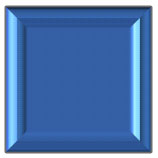How to Change Lighting Colors 3 D Bevel Powerpoint 2016
3-D Format Options for Shapes in PowerPoint 2010 for Windows
Explore 3-D Format options for shapes in PowerPoint 2010 for Windows. You can alter top and bottom bevels, depth, contour, material, and lighting.
Author: Geetesh Bajaj
Product/Version: PowerPoint 2010 for Windows
OS: Microsoft Windows XP and higher
3-D Options in PowerPoint 2010 let you format the bevel style of a shape with many more options than those available in the conventional Bevel gallery you explored in our Apply Bevel Effects to Shapes In PowerPoint 2010 tutorial. You can customize options such as contour, contour color, depth, depth color, and materials. This detailed tutorial explains every option within the 3-D Options gamut. To see a sample presentation containing 3-D Options in PowerPoint 2010 for Windows, scroll down to the bottom of this page. Follow these steps to format 3-D Options: Note: The Drawing Tools Format tab is a Contextual tab. These tabs are special tabs in the Ribbon that are not visible all the time. They only make an appearance when you are working with a particular slide object which can be edited using special options. Note: Click the Reset button to convert a 3-D formatted shape back to a 2-D shape (see Figure 4 above). Sample Presentation: Click below to view this presentation on SlideShare Click below to view this presentation on YouTube

Figure 1: Drawing Tools Format tab of the Ribbon

Figure 2: 3-D Options in the Preset gallery 
Figure 3: 3-D Options in the Bevel gallery 
Figure 4: 3-D Format options within Format Shape dialog box A. Bevel

Figure 5: Top Bevel 
Figure 6: Bottom Bevel B. Depth

Figure 7: Depth and color options for Depth Theme Colors
Standard Colors
Recent Colors
More Colors

Figure 8: Standard tab of the Colors dialog box 
Figure 9: Custom tab of the Colors dialog box C. Contours

Figure 10: Contour color and size options D. Surface

Figure 11: Material 
Figure 12: Lighting 
Figure 13: Rectangle shape with 3-D effects applied
See Also:
Shape Effects: 3-D Format Options for Shapes (Glossary Page)
3-D Format Options for Shapes in PowerPoint 2016 for Windows
3-D Format Options for Shapes in PowerPoint 2013 for Windows
3-D Format Options for Shapes in PowerPoint 2011 for Mac
3-D Format Options for Shapes in PowerPoint 2007 for Windows
3-D Format Options for Shapes in PowerPoint 2003 for Windows
You May Also Like: Essential PowerPoint Skills Everyone Needs, Especially Working from Home | Cyprus Flags and Maps PowerPoint Templates
Popular Posts

Ten Easy Topics for Pecha Kucha
But what are simple topics, that excite you, and are interesting to your audiences? Of course, if you already have a topic, you need not read further, but if you are still looking for ideas, here are ten easy topics that you can use for your Pecha Kucha presentations.



This is the original page. An AMP (Accelerated Mobile Page) version of this page is also available for those on mobile platforms, at 3-D Format Options for Shapes in PowerPoint 2010 for Windows.
Microsoft and the Office logo are trademarks or registered trademarks of Microsoft Corporation in the United States and/or other countries.
Plagiarism will be detected by Copyscape
How to Change Lighting Colors 3 D Bevel Powerpoint 2016
Source: https://www.indezine.com/products/powerpoint/learn/fillslinesandeffects/3-d-options-in-ppt-2010.html
0 Response to "How to Change Lighting Colors 3 D Bevel Powerpoint 2016"
Post a Comment